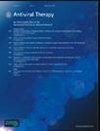一个包括定量抗-HBc的基线模型预测聚乙二醇干扰素在HBeAg阳性慢性乙型肝炎患者中的反应
IF 2.3
4区 医学
Q4 INFECTIOUS DISEASES
引用次数: 2
摘要
背景在乙型肝炎e抗原(HBeAg)阳性的慢性乙型肝炎患者中,很少有预测聚乙二醇干扰素抗病毒反应的模型,预测效果不理想。乙型肝炎核心抗原的定量抗体(抗-HBc)是一种新的治疗反应预测指标。我们旨在开发一种新的模型来识别HBeAg阳性的中国患者,他们更有可能对聚乙二醇干扰素产生反应。方法应用广义加性模型和多元逻辑回归分析对140例HBeAg阳性聚乙二醇干扰素受体的数据进行基线评分,以预测血清学反应(SR:HBeAg丢失和治疗后24周HBeAg血清转换)和联合反应(CR:SR加血清HBVDNA水平1.96,p<0.05)和Lampertico's(Z=2.06>1.96,p<0.05)模型。在第12周评分为0且乙型肝炎表面抗原≥20000IU/mL的患者中,SR和CR的阴性预测值均为100%。结论基线评分较高的患者更有可能对聚乙二醇干扰素产生反应。这个新模型可以预测治疗反应。本文章由计算机程序翻译,如有差异,请以英文原文为准。
A baseline model including quantitative anti-HBc to predict response of peginterferon in HBeAg-positive chronic hepatitis B patients
Background Few models to predict antiviral response of peginterferon were used in hepatitis B e antigen (HBeAg)-positive chronic hepatitis B patients and the prediction efficacy was unsatisfied. Quantitative antibody to hepatitis B core antigen (anti-HBc) is a new predictor of treatment response. We aimed to develop a new model to identify HBeAg-positive Chinese patients who were more likely to respond to peginterferon. Methods Data from 140 peginterferon recipients with HBeAg-positive were applied with generalized additive models and multiple logistic regression analysis to develop a baseline scoring system to predict serological response (SR: HBeAg loss and HBeAg seroconversion 24 weeks post-treatment) and combined response (CR: SR plus serum HBV DNA levels <2000 IU/mL 24 weeks post-treatment). Results Anti-HBc levels, alanine aminotransferase ratio, and HBeAg were retained in the final model. The new model scored from 0 to 3. Among patients with scores of 0, 1, or ≥2, SR was achieved in 6.45% (2/31), 13.21% (7/51), and 55.36% (31/56), respectively, and CR in 3.23% (1/31), 9.43% (5/53), and 25.00% (14/56), respectively. Our model has a higher AUROC for SR comparing to Chan’s (Z = 2.77 > 1.96, p < 0.05) and Lampertico’s (Z = 2.06 > 1.96, p < 0.05) model. The negative predictive value for SR and CR were both 100% in patients with score 0 and hepatitis B surface antigen ≥20,000 IU/mL at week 12. Conclusions Patients with higher scores at baseline were more likely to respond to peginterferon. This new model may predict the treatment response.
求助全文
通过发布文献求助,成功后即可免费获取论文全文。
去求助
来源期刊

Antiviral Therapy
医学-病毒学
CiteScore
2.60
自引率
8.30%
发文量
35
审稿时长
4-8 weeks
期刊介绍:
Antiviral Therapy (an official publication of the International Society of Antiviral Research) is an international, peer-reviewed journal devoted to publishing articles on the clinical development and use of antiviral agents and vaccines, and the treatment of all viral diseases. Antiviral Therapy is one of the leading journals in virology and infectious diseases.
The journal is comprehensive, and publishes articles concerning all clinical aspects of antiviral therapy. It features editorials, original research papers, specially commissioned review articles, letters and book reviews. The journal is aimed at physicians and specialists interested in clinical and basic research.
 求助内容:
求助内容: 应助结果提醒方式:
应助结果提醒方式:


